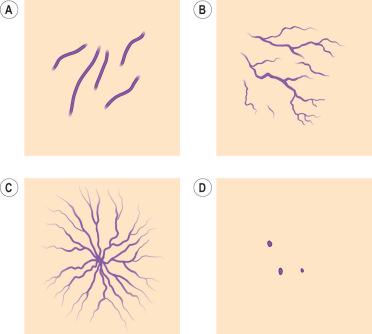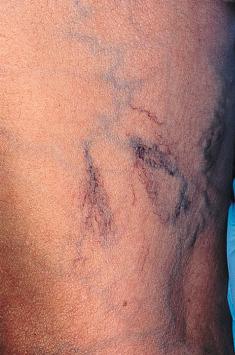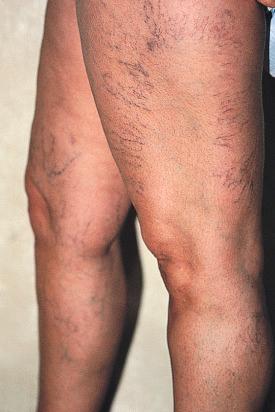Physical Address
304 North Cardinal St.
Dorchester Center, MA 02124
The term telangiectasia was coined in 1807 by Von Graf to describe a superficial vessel of the skin visible to the human eye. These vessels measure 0.1–1 mm in diameter and represent an expanded venule, capillary or arteriole. Telangiectasias that originate from arterioles on the arterial side of a capillary loop tend to be small and bright red and do not protrude above the skin surface. Telangiectasias that originate from venules on the venous side of a capillary loop are blue, wider, and often protrude above the skin surface. Sometimes, telangiectasias, especially those arising at the capillary loop, are red at first but with time become blue, probably because of increasing hydrostatic pressure and backflow from deep veins.
Redisch and Pelzer classified telangiectasias into four types based upon clinical appearance ( Fig. 4.1 ):
Sinus or simple (linear)
Arborizing
Spider or star
Punctiform (papular)

Papular telangiectasias are frequently present in patients with collagen vascular disease. Spider telangiectasias are red and arise from a central filling vessel of arteriolar origin. Red linear telangiectasias occur on the face (especially the nose) or legs. Blue linear or anastomosing telangiectasias are found most often on the legs.
Raymond-Martimbeau and Dupuis proposed another classification based on the relationship between telangiectasias and superficial as well as deep veins. Using duplex ultrasound, they evaluated 525 consecutive patients with 884 zones of telangiectasia without underlying saphenous or perforator vein incompetence. They found that 8.8% of the telangiectasias joined the deep venous system, 12.6% joined the superficial venous system, 71.2% were directly connected to reticular veins and 7.4% had no obvious connection. This is in contradistinction to the reports of very high incidence of arterial venous anastomoses for leg telangiectasias.
The actual etiology of telangiectasias may be identical to that of varicose veins. However, the findings of Raymond-Martimbeau and Dupuis suggest that valvular damage occurs with subsequent venous hypertension that is transmitted to epidermal vessels, which then elongate and dilate. Our research has implicated a leukocyte–endothelial interaction that relates intercellular adhesion molecule-1 and monocytes to adherence and migration of cells. Valve and vein wall damage is produced by monocytes in the interstitial tissue. Thus, pharmacologic treatment of telangiectasias may be possible in the future.
This chapter discusses the pathophysiology and anatomy of telangiectasias occurring on the lower extremities.
Two common patterns of telangiectasias on the legs of women, besides red or blue streaks, are the parallel linear pattern, usually found on the medial thigh ( Fig. 4.2 ), and the arborizing or radiating cartwheel pattern, seen most often on the lateral thigh ( Fig. 4.3 ). These two subsets of telangiectasias seem to run in families and may form anastomosing complexes as large as 15 cm in diameter. The arborizing type on the lateral thigh usually appears with ‘feeding’ reticular veins (see Fig. 1.11 ). These complexes have been termed venous stars , sunburst venous blemishes and spider leg veins by various authors.


The pathogenesis of each type of telangiectasia is somewhat different. Multiple factors may play a role in the development of new blood vessels or the dilation of existing blood vessels (see Chapter 3 ). Acquired telangiectasias probably result from the release or activation of vasoactive substances, such as hormones and other chemicals. Conditions associated with increased or activated vasoactive substances include anoxia, infection and certain physical factors that result in capillary or venular neogenesis. One common area for the development of telangiectasia is the medial thigh. This has been thought to be, in part, a result of pressure exerted by crossing the legs. A report on tissue atrophy in a woman with associated telangiectasia at the site of pressure where her legs crossed suggests that intermittent pressure results in subcutaneous tissue loss or atrophy. Unfortunately, to our knowledge, no formal studies on tissue pressure have been performed. Box 4.1 , an extension of observations made by Shelley as well as Anderson and Smith, lists the major etiologies associated with telangiectasias arising on the lower extremities.
Nevus flammeus
Klippel–Trénaunay syndrome
Nevus araneus
Angioma serpiginosum
Bockenheimer syndrome
Maffucci syndrome
Congenital poikiloderma (Rothmund–Thomson syndrome)
Essential progressive telangiectasia
Cutis marmorata telangiectatica
Diffuse neonatal hemangiomatosis
Systemic lupus erythematosus
Dermatomyositis
Progressive systemic sclerosis
Cryoglobulinemia
Telangiectasia macularis perstans (mastocytosis)
Human immunodeficiency virus [human T-lymphotropic virus, type III (HTLV-III)]
Varicose veins
Keratosis lichenoides chronica
Necrobiosis lipoidica diabeticorum
Capillaritis (purpura annularis telangiectodes)
Malignant atrophic papulosis (Degos disease)
Pregnancy
Estrogen therapy
Topical corticosteroid preparations
Actinic neovascularization and/or vascular dilation
Contusion
Surgical incision/laceration
Generalized essential telangiectasia
Progressive ascending telangiectasia
Human immunodeficiency virus (HTLV-III)
Radiodermatitis
Erythema ab igne (heat/infrared radiation)
The incidence of varicose and telangiectatic leg veins in the general population is presented in Chapter 2 . The relationship between varicose veins and spider leg veins (telangiectasias) is profound. The anatomy and pathophysiology of telangiectasia is presented in Chapters 1 and 3 . Telangiectasias increase in incidence with advancing age. Among neonates, the prevalence of telangiectasias is 3.8%, with 26% occurring on the legs.
Two surveys have detailed the characteristics of patients seeking treatment of unwanted spider leg veins. Duffy, in a nonrandomized survey of his patients, reported a 90% family history of varicose or telangiectatic leg veins. Patients included three sets of identical twins with similar-appearing leg telangiectasias. Sadick, in a nonrandomized survey of 100 patients seeking treatment, found a 43% family history of varicose or telangiectatic leg veins. Both surveys found that one third of the patients first noted the development of these veins during pregnancy. Among this subset of patients, veins became most severe after the third pregnancy. Between 20% and 30% of patients developed these veins before pregnancy, and 18% of women noted the onset of the veins while taking oral contraceptives. Both authors concluded that the development of leg telangiectasia is probably a partially sex-linked, autosomal dominant condition with incomplete penetrance and variable expressivity.
Become a Clinical Tree membership for Full access and enjoy Unlimited articles
If you are a member. Log in here